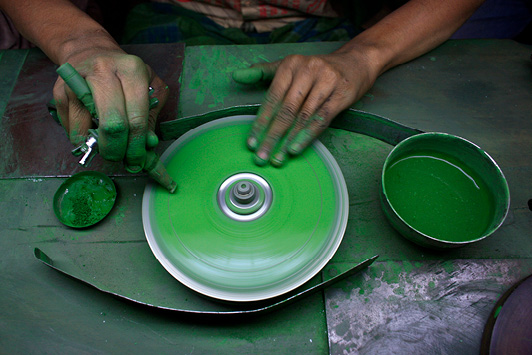
As the world’s largest importer of rough, India is a major player in the world diamond market. But the nation plays a leading role in the colored-gemstone industry as well. In Jaipur alone, known as the Pink City of India, there are more than 300,000 skilled artisans working in the trade.
“Similar to the diamond sector in India, another sector that is known across the world for its cutting and polishing skills is the colored-gemstone sector,” says Pramod Agarwal, chairman of the Gem & Jewellery Export Promotion Council (GJEPC).
While the country’s diamond industry is relatively new, its colored-gemstone trade has a longer history, adds Rajiv Jain, chairman of Sambhav Gems, who formerly chaired the GJEPC.
“The colored-gemstone industry of Jaipur is as old as the city of Jaipur. Maharaja [King] Sawai Jai Singh, the founder of the city and a connoisseur of crafts and luxury, invited skilled craftsmen to settle in Jaipur and practice their craft,” he relates. “He took a keen interest in inviting jewelers from across the country and this is how Jaipur eventually became the hub for cutting and polishing colored gemstones.”
Branching out
Jaipur cuts and polishes more than 100 stone varieties — primarily emeralds, rubies, tanzanite and aquamarine, according to Jain. But in the early 1990s, the industry decided it needed an edge. So Jaipur’s manufacturers took the next step: designing jewelry with colored gemstones.
“Mumbai is the hub for diamond jewelry, and Jaipur has become the hub for colored gemstone jewelry, both in gold and silver,” Jain explains. At the same time, the city embraced new technology for cutting and polishing gems.
The industry’s expansion efforts have borne fruit, according to Agarwal. “The GJEPC, through its promotional activities and events, has created business opportunities for the colored-gemstone sector across the world. The recently organized India Gemstone Week in Jaipur was a successful one that focused on potential markets like China and Russia.”
Still, he continues, demand for colored gemstones has seen only modest growth in the past few years. India exported $433.3 million worth of colored gems in the 2017-18 financial year, compared with $420.1 million in fiscal 2016-17. The major markets were Hong Kong, the US and Thailand.
The roadblocks
Unlike in the diamond trade, where big names like Alrosa and De Beers help assure a consistent supply of rough, a strong player has yet to emerge in the colored-gemstone industry. The inconsistent supply of raw materials is one of the biggest challenges the sector faces.
“There are a host of constraints in doing this business, because we have to rely majorly on imports of rough stones from different countries,” says Jain. “Also, the countries that supply these stones are actively setting up cutting and polishing units within their country. Very few stones are found in India, [so] we have to rely heavily on stones coming from Africa, Brazil and Latin America.”
He praises London-based gemstone producer Gemfields for working to ensure a steady supply of raw materials in the trade. But he also suggests that there is room for more players, while stressing that the colored stones India cuts and polishes are responsibly sourced.
“There are very small miners all around the world, and it is not as organized as the diamond industry, but in India…everything that comes in is through a proper channel and whatever goes out is also through a proper channel,” he declares. “This helps avoid unethical practices such as mixing of goods.”
Image: Getty/Palani Mohan; ShutterstockArticle from the Rapaport Magazine - August 2018. To subscribe click here.